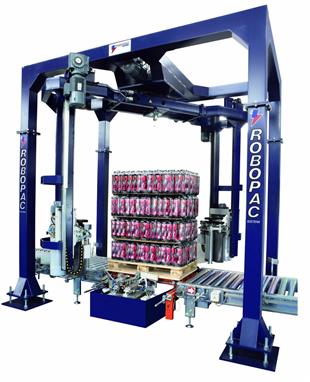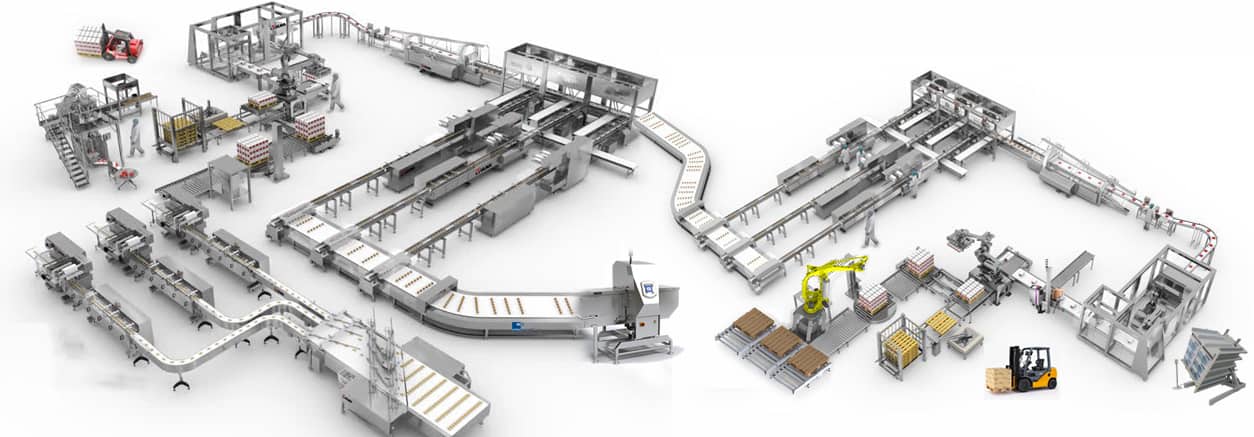WHY ‘END-OF-LINE’ IS THE START OF A JOURNEY
Tim Ansell, Sales Director of Al Thika Packaging shares his thoughts on the regional end-of-line packaging, market scenario and its potential.
Ten years ago, persuading even a major manufacturer in the Gulf to automate just one part of its end-of-line process, was, if not an exercise in complete futility, certainly one with few rewards. There were several reasons for this, the first, typically, that “Labour is cheap so it’s not worth investing in automation” but others, sometimes spoken though often not, included “Our operators will break it” and “We’re afraid to change our ways”. Discussions around the subject of automation would roll on for months, even years, before interest waned and the end user and supplier simply moved on.
But times, and attitudes, have changed immensely, and this has driven significant growth in the end-of-line solutions sector in this region over the last few years. Whilst there are many factors behind the trend, perhaps the most significant has been the ever increasing cost of employing, insuring, accommodating, and transporting a large labour force, and with it, the realisation that if production line workers are going to cost a company a great deal more, it seems reasonable that they should be better qualified and more skilled.
The return on investment (ROI) on the purchase of a carton erector-loader, inline pallet wrapper, or automated warehouse conveyor for example, suddenly begins to make a lot more sense, if that machinery can be operated by fewer, better-paid staff possessing thorough technical skills, especially when line efficiency improves as a result.
Automation, of course, also brings with it the advantage of consistency; ask three small teams of manual labourers to tape up, load, close, and label a shipping carton, then stack 60 of those cartons on a pallet, and you’ll likely end up with three very different looking pallets (or six, if you include the ones they pack late on a Thursday afternoon!).
Consistency of shipping carton presentation and pallet loading in turn means fewer warehousing and logistical problems, along with lower levels of retailer rejection, whilst potentially creating opportunities for greater warehouse management automation.
In fact, manufacturers now are taking a very different view of end-of-line automation, having moved on from ‘What’s the point?” to ”At what point do we stop?”
For example, we recently supplied a date farm in Saudi Arabia with a fully automated packing line designed to erect cartons lined with a plastic bag, fill those cartons with a precisely weighed load of dates, seal the bag, then close the box, at a rate of approximately 50kg/minute.
Automatic pallet wrapping at high speeds by Robopac Sistemi
The original enquiry was simply for a carton taper, but it became clear during our initial discussions that the real problem the customer faced was not one of closing the cartons, but of having to move staff from the packing shed to his farm, since he could no longer obtain visas for unskilled workers.
When he realised that we could in fact totally automate the entire process, reducing his headcount in the packing area from 35 to just 4 labourers, the customer’s mindset changed completely from “How much will it cost?” to “How soon can you deliver?” In this case, automation hasn’t just improved the company’s process; it’s actually allowed it to stay in business!
Whilst this is an extreme example, it highlights an issue faced by all food, non-food & beverage manufacturers looking to automate, that of ‘mission creep’. The introduction of any piece of equipment onto a production line, be it in the processing, assembly, or packaging process, should bring about, at the very least cost savings, but equally likely, improvements in efficiency and thus output.
But that improvement in production, and thus ROI, can only be realised if the equipment or staff downstream can cope with the increased demand. If not, the plant manager will need to look at improving the next process down the line, then the next, and so on and so forth, until his head is spinning with technical specifications and his budget blown sky high.
That is where the project department of a good supplier can make a huge difference to the success or failure of automating all, or part of a production line. By taking into consideration production targets, budgets, space restrictions, material specifications, and many more factors, a project manager can tailor a solution designed to maximise overall equipment efficiency – and to bring it in on budget.
Furthermore, if planned correctly from the outset, any equipment supplied can be designed to be future proof, so as additional capital expenditure becomes possible, further equipment can slot seamlessly into the line.
A good project manager should also take it upon himself to highlight opportunities to incorporate equipment which might have been impractical under a manual packing regime, but which becomes feasible on an automated line.
When products are presented in a uniform position, always in the same orientation, suddenly solutions such as automated labelling, check-weighing with feed-back control, or camera inspection, become a viable option. Again, whilst this will require greater investment, it will also mean an improvement in pack appearance, automated quality procedures, a reduction in complaints from the market, and potentially huge savings by reducing giveaway.
When a production department has made a decision to automate and we explain the availability of equipment used to assure quality, we find other departments are sometimes willing to share budget resources if they understand the opportunity.
In line inspection by Mettler Toledo easier when packs are consistent
You wouldn’t upgrade from a Toyota Corolla to an AMG Mercedes and expect to use the same tyres, the cheapest fuel, and the same mechanic to operate the Mercedes. Yet, so often, that is precisely the stance taken by purchasing departments, who see paying a higher price for better quality materials almost as an affront to their profession.
What the company’s management HAS to ensure, is that long before the new line arrives, purchase officers understand that it simply will not run at maximum efficiency if fed with the cheapest possible materials. Any good machinery supplier will be able to provide the specifications of material required to run their equipment and, in many cases, these will be more expensive than those which the purchasing department is comfortable buying.
It is therefore absolutely vital that the purchasing department accept, for example, that if a pallet wrapper can apply five times more stretch to a film than a manual operator, using a cheap but weak stretch film, which tears every five minutes on the machine, no longer makes sense.
Instead, let them understand the maths; if a good film costs 20% more to buy, but yields 400% more pallets, then the company is going to make huge savings. The same logic applies to shrink films, shipping cartons, labels, pallets, and any number of other materials, all of which are a critical part of an automated line, and which must be considered as such. The purchasing department has to adopt a whole new mindset, understanding that changes in shop floor processes must be matched by changes in their own procedures.
In summary, end-of-line automation creates huge opportunities for food and beverage manufacturers, not just to increase productivity, but to improve their processes in many other ways, through enhanced quality control, improved operator welfare, better pack appearance, simplified stock management etc.
But it must be viewed as much more than just adding a few machines to the line; it requires careful evaluation of the processes upstream and downstream, detailed, early consultation with suppliers, a readiness to incorporate methods not previously used on site, and a willingness to make the project a success, not just on the production line, but throughout the company.
Since 1994 Al Thika Packaging LLC has been providing packaging, sorting, coding & inspection machinery solutions for food, non-food & beverage industries in Dubai, Abu Dhabi, Sharjah, Fujairah, Ras Al Khaimah, Ajman, Umm Al Quwain, Al Ain – UAE, Saudi Arabia, Bahrain, Oman and the many other Gulf countries.





